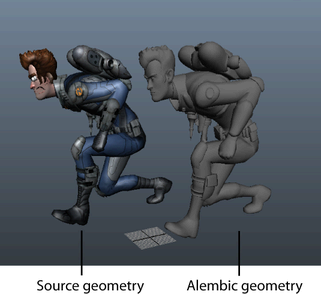You can use Alembic caches in Maya to transfer assets between various stages of your production pipeline. The contents of Alembic cache files are evaluated as Maya geometry and can be modified with polygon, NURBS, and subdivision surface editing tools.
When you import (Pipeline Cache > Alembic Cache > Alembic Import ) or open (Pipeline Cache > Alembic Cache > Open Alembic) Alembic caches in Maya, the object hierarchies in the file are maintained. Alembic caches do not include shading information and appear in the scene view with default shading. After loading an Alembic file, you can assign shaders to the objects using the same materials and workflows as Maya geometry.
You can specify export and import options that let you merge Alembic file with the shading information of the source geometry. See Merge Alembic caches with Maya objects. Shaded Alembic objects can be rendered with Maya Software or mental ray renderers.

You can specify Alembic export (Pipeline Cache > Alembic Cache > Export) options that let you:
You can specify Alembic import (Pipeline Cache > Alembic Cache > Alembic Import) options that let you:
Alembic import options are not available when you use the open commands. See Import Alembic cache files.
To save and load Maya objects and scenes as Alembic caches, load the AbcImport.mll and AbcExport.mll plug-ins. To load the plug-ins, open the Plug-in Manager ( Windows > Settings/Preferences > Plug-in Manager). See Load or unload Maya plug-ins.
 Except where otherwise noted, this work is licensed under a Creative Commons Attribution-NonCommercial-ShareAlike 3.0 Unported License
Except where otherwise noted, this work is licensed under a Creative Commons Attribution-NonCommercial-ShareAlike 3.0 Unported License